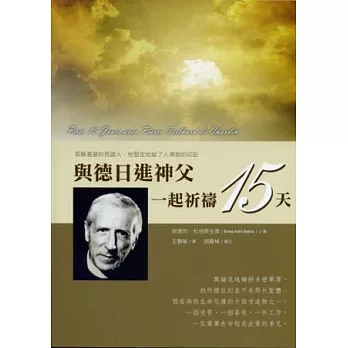與德日進神父一起祈禱15天
Prier 15 jours avec Pierre Teilhard de Chardin
彼得·布賴恩·梅達沃爵士,OM,CBE,FRS(Sir Peter Brian Medawar,1915年2月28日-1987年10月2日),是一位出生於巴西里約熱內盧的英國科學家,主要研究免疫學。他與弗蘭克·麥克法蘭·伯內特一起獲得了1960年的諾貝爾生理學或醫學獎。
我讀者 Sir Peter Brian Medawar的一些書以及他過世之後太太寫的一些回憶錄Medawar, Jean (1990). A Very Decided Preference. OUP
Jean Shinglewood Medawar (née Taylor; July 2, 1913[1] – May 3, 2005)
Books
Medawar was recognized as a brilliant author: Richard Dawkins called him "the wittiest of all scientific writers"[11] and New Scientist magazine's obituary called him "perhaps the best science writer of his generation".[12] He was also awarded the 1987 Michael Faraday Prize "for the contribution his books had made in presenting to the public, and to scientists themselves, the intellectual nature and the essential humanity of pursuing science at the highest level and the part it played in our modern culture".
His books include The Uniqueness of Man, which includes essays on immunology, graft rejection and acquired immune tolerance; Induction and Intuition in Scientific Thought; The Art of the Soluble, a book of essays, later reprinted in Pluto's Republic; Advice to a Young Scientist; Aristotle to Zoos (with his wife Jean Shinglewood Taylor); The Life Science, The Limits of Science and his last, in 1986, Memoirs of a Thinking Radish, an autobiography. 這本書中國有翻譯: 一只会思想的夢卜 : 彼得.梅达沃自传 / 彼得.梅达沃著 ; 袁开文等译
上海市 : 上海科技敎育出版社, 1999
Memoir of a thinking radish : an autobiography / Peter Medawar
Oxford ; New York : Oxford University Press, 1986
One of his best-known essays is his 1961 criticism of Pierre Teilhard de Chardin's The Phenomenon of Man, of which he said: "Its author can be excused of dishonesty only on the grounds that before deceiving others he has taken great pains to deceive himself".[13][14]
- The Future of Man: the BBC Reith Lectures 1959, Methuen, London 1960
- Induction and Intuition in Scientific Thought, Methuen & Co. London 1969
- The Hope of Progress: A Scientist looks at Problems in Philosophy, Literature and Science, Anchor Press / Doubleday, Garden City 1973
- The Threat and the Glory: Reflections on Science and Scientists (ed.: David Pyke), a posthumously collected volume of essays, Harper Collins 1980
臺灣大學
Advice to a young scientist / P. B. Medawar
New York : Harper & Row, c1979 這本台灣可能有翻譯
Induction and intuition in scientific thought / P.B. Medawar
London ; New York : Routledge, 2009
The limits of science / P.B. Medawar
Oxford [Oxfordshire] : Oxford University Press, c1986
Aristotle to zoos : a philosophical dictionary of biology / P.B. Medawar & J.S. Medawar
Cambridge, Mass. : Harvard University Press, 1983
The logic of scientific inference : an introduction / Jennifer Trusted ; foreword, Peter Medawar
London : Macmillan, 1979
Biography
 Peter Brian Medawar was born on February 28, 1915, in Rio de Janeiro. He is the son of a business man who is a naturalized British subject, born in the Lebanon.
Peter Brian Medawar was born on February 28, 1915, in Rio de Janeiro. He is the son of a business man who is a naturalized British subject, born in the Lebanon.
Medawar was educated at Marlborough College, England, where he went in 1928. Leaving this College in 1932, he went to Magdalen College, Oxford, to study zoology under Professor J. Z. Young. After taking his bachelor's degree at Oxford, Medawar worked for a time at Sir Howard Florey's School of Pathology at Oxford and there became interested in research in fields of biology that are related to medicine.
In 1935 he was appointed Christopher Welch Scholar and Senior Demonstrator at Magdalen College, Oxford, and in 1938 he became, by examination, a Fellow of Magdalen College. In 1942 he was Rolleston Prizeman and in 1944 he became Senior Research Fellow of St John's College, Oxford, and University Demonstrator in zoology and comparative anatomy. In 1946 he was elected a Fellow of Magdalen College, Oxford, and in 1947 he was appointed Mason Professor of Zoology at the University of Birmingham. In 1951 he moved to London as Jodrell Professor of Zoology at University College, London. Here he remained until 1962, when he was appointed Director of the National Institute for Medical Research, London.
Medawar's earlier research, done at Oxford, was on tissue culture, the regeneration of peripheral nerves and the mathematical analysis of the changes of shape of organisms that occur during this development. During the early stages of the Second World War he was asked by the Medical Research Council to investigate why it is that skin taken from one human being will not form a permanent graft on the skin of another person, and this work enabled him to establish theorems of transplantation immunity which formed the basis of his further work on this subject. When he moved to Birmingham in 1947 he continued to work on it, in collaboration with R. Billingham, and together they studied there problems of pigmentation and skin grafting in cattle, and the use of skin grafting to distinguish between monozygotic and dizygotic twins in cattle. In this work they took into consideration the work of R. D. Owen and concluded that the phenomenon that they called «actively acquired tolerance» of homografts could be artificially reproduced. For this earlier work on transplantation and growth, Medawar was elected a Fellow of the Royal Society, London. When he moved to London in 1951, Medawar continued to work with R. Billingham and L. Brent, on this phenomenon of tolerance, and his detailed analysis of it occupied him for several years. He also carried out other researches into transplantation immunity.
The Royal Society of London, where he was the Croonian Lecturer in 1958, awarded him the Royal Medal in 1959. In the same year, he was Reith Lecturer for the British Broadcasting Corporation. He has been elected a Foreign Member of the New York Academy of Sciences, the American Academy of Arts and Sciences, and the American Philosophical Society.
In 1937 Medawar married Jean Shinglewood Taylor, daughter of a Cambridge physician. They have two sons, Charles and Alexander, and two daughters, Caroline and Louise.

沒有留言:
張貼留言